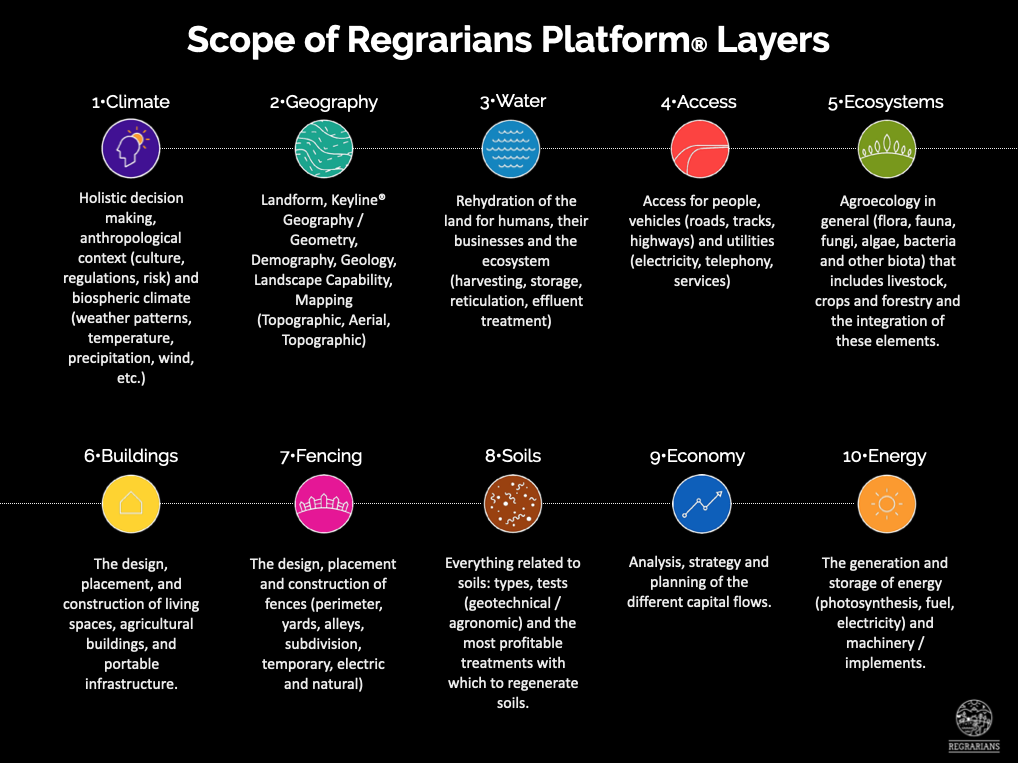Regrarians Platform®
Effective planning is always based on organising frameworks which provide a solid and proven process to follow.
“…I believe this is one of the most profound assessments of human-ecology dependencies that exist…”
—Joel Salatin, in the ‘The Marvelous Pigness of Pigs’, referring to the Regrarians Platform®
Origins
In 2006, Regrarians’ founder Darren J. Doherty (CPAg AIA) started the process which culminated in what is now called the Regrarians Platform®. This platform covers the broad topics that Regrarians Ltd. addresses as part of its global extension and outreach. The Regrarians Platform builds on ‘The Keyline scale of (relative) permanence’ (‘KSOP’)—a concept first outlined in 1958 in “The Challenge of Landscape — The Development and Practice of Keyline” by P.A. Yeomans (1905-1984), an Australian mining and agricultural engineer.
And so with this we broadened the scope and number of Yeomans’ factors—reflecting the increased complexity of agroecological landscape and enterprise planning that have become more obvious and understood over the 6 decades since Yeomans first came up with the KSOP concept.
The Regrarians Platform has been developed to provide a structure for a strategic, holistic and logical process to agroecological landscape and enterprise planning which ensures all elements are taken into account:
In this book Yeomans’ made the suggestion that the KSOP factors were not complete, opening the way for our development of the Regrarians Platform:
1•CLIMATE
Concerns the various climates of an enterprise, be they Human or Biospheric. Effectively these climates create ‘the rules of the game’ in the application of the Regrarians Platform.
2•GEOGRAPHY
The ‘board game’ in the Regrarians Platform. The Geography of a place implies it place in the region along with the physical elements with which it interacts and includes topography, demography & geology.
3•WATER
The water an enterprise has available to it is relatively fixed. We should be concerned with how we make the best use of what’s available and use the Climate & Geography (& capital) as best we can in order to maximise the use of this critical resource.
4•ACCESS
Roads, Tracks & Lanes are very permanent features and influential features in landscapes. Their placement defines our movement and should integrate the all of the elements we use these connective pathways with.
5•ECOSYSTEMS
Biodiverse agroecosystems are composed of flora, fauna, fungi, bacteria & algae. These communities whether nature or composed can be complex in their outcomes & their placement are critical to support & provide for other systems.
6•BUILDINGS
An array of structures on any holding are necessary to make the artificial sedentary production systems that humans call agriculture possible. Placement and design should follow that of other layers especially Climate, Geography, Water & Access.
7•FENCES
How we subdivide our landscapes should follow the lines of other more permanent layers. We should concentrate our efforts on using the most flexible of fencing infrastructure in order to accommodate the changing opportunities and yields that occur in the landscape.
8•SOILS
Easily destroyed and fortunately easily created, soils are the foundation to the economy of life. Management is the critical to the development & maintenance of soils. The soil’s protection is enhanced by considering other layers, particularly Water, Ecosystems & Fences.
9•ECONOMY
The analysis of the market & access to it has never been easier. The difficulty remains in the terms of trade, particularly with regards compliance, though slowly the tide is turning as humans are incredibly enterprising, adaptable & difficult to quell.
10•ENERGY
Nothing is as fleeting as a photon of light and the primary role of humanity must be to enhance photosynthesis at every opportunity & encourage its positive side-effects, with nearly all energy system that humans access originating from the sun.




